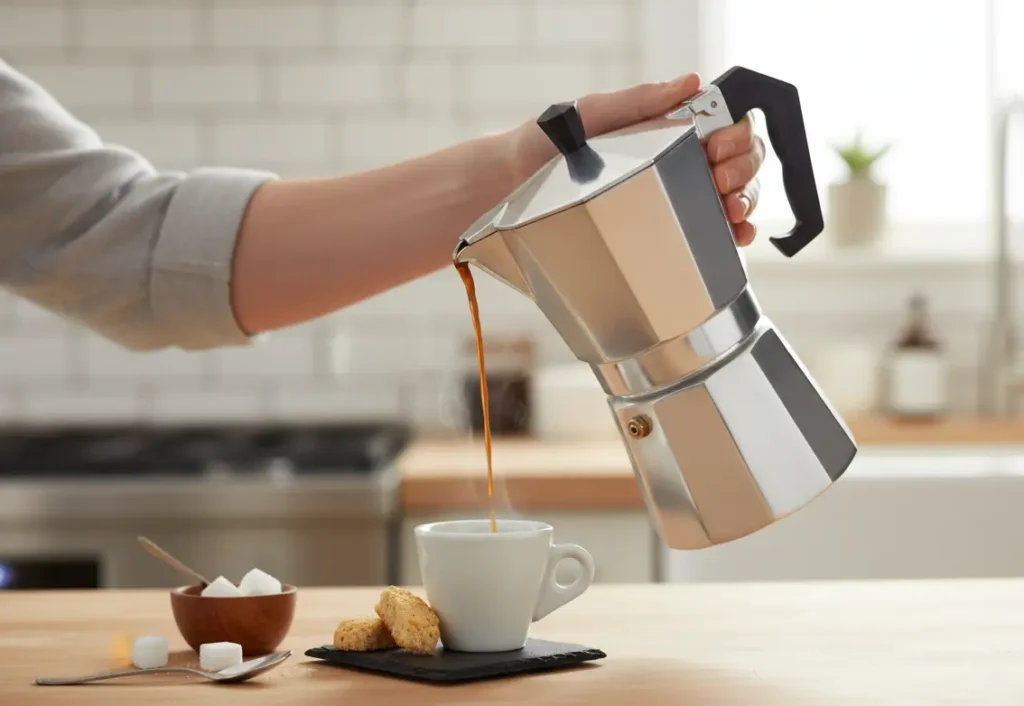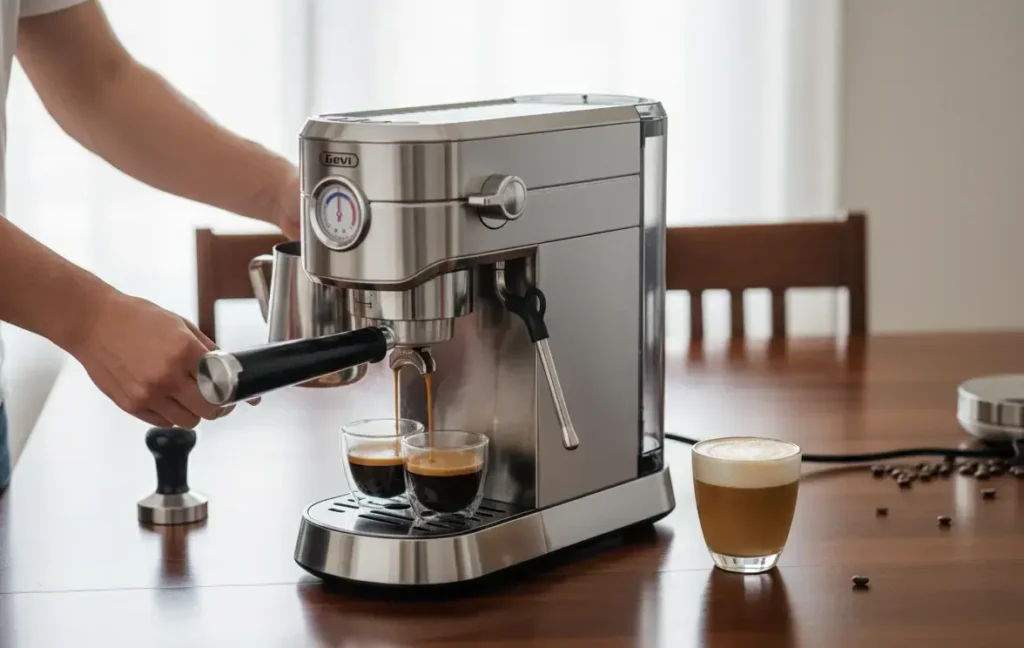Is your coffee machine not brewing like it used to? Low or inconsistent pressure can ruin your perfect cup, leaving you frustrated and tired.
But don’t worry—fixing your coffee machine’s pressure is easier than you think. In this guide, you’ll discover simple steps to get your machine working like new again. Keep reading, and you’ll soon enjoy rich, delicious coffee every morning without the hassle.

Common Pressure Issues
Pressure issues in coffee machines affect brewing quality and taste. Knowing common problems helps fix them faster. Pressure controls water flow and extraction. Wrong pressure changes coffee flavor and texture. Detecting issues early saves repair costs and frustration.
Low Pressure Signs
Slow water flow during brewing is a clear sign. Coffee may taste weak or sour. Machine may take longer to brew a cup. Steam wand pressure feels weak or soft. Espresso shots appear thin and watery. The pump may sound quieter or struggle.
According to Breville USA, espresso machines are engineered to brew at around 9 bars of pressure, and when the pressure drops below that level, the coffee often tastes weak or sour because it becomes under-extracted. This is one of the most common indicators that your machine isn’t reaching proper pressure levels.
High Pressure Symptoms
Water sprays out too fast or unevenly. Coffee tastes bitter or burnt. Espresso shot pours too quickly with little crema. Steam wand pressure feels too strong or harsh. The machine may hiss loudly or shake. Over-extracted coffee means too much pressure.
Causes Of Pressure Problems
Clogged filters or pipes reduce water flow. Worn-out pump or pressure valve malfunctions. Scale buildup blocks water pathways. Incorrect grind size affects pressure balance. Faulty pressure gauges give wrong readings. Loose or broken seals cause leaks and pressure drops.
Tools Needed For Adjustment
Fixing the pressure of a coffee machine needs the right tools. These tools help adjust the machine safely and correctly. Having them ready saves time and avoids damage.
Each tool serves a special purpose in the adjustment process. Knowing what to use makes the task easier and more effective.
Pressure Gauge
A pressure gauge shows the exact pressure inside the machine. It helps check if the pressure is too high or too low. You can see real-time changes during adjustment. Some machines have a built-in gauge, but an external one works too.
Screwdrivers And Wrenches
Screwdrivers and wrenches allow you to open parts and turn screws. They help reach the pressure valve or pump. Different sizes may be needed for different screws or bolts. Using the right tool avoids stripping or breaking parts.
Cleaning Supplies
Cleaning supplies keep the machine free from blockages. Dirt and coffee oils can affect pressure. Use brushes, cloths, and cleaning solutions made for coffee machines. Clean parts before and after adjustments to ensure smooth operation.
Step-by-step Pressure Fix
Fixing your coffee machine’s pressure is key for great coffee. Low or high pressure changes taste and texture. Follow these clear steps to get your machine working right again.
Checking The Pressure
Start by checking the pressure gauge on your machine. It shows if the pressure is too low or high. Turn the machine on and watch the gauge during brewing. Note the pressure reading. It should be close to the machine’s recommended level. If not, the pressure needs adjustment.
Adjusting The Pressure Regulator
Find the pressure regulator inside the machine. Use a screwdriver to turn the regulator screw. Turn it slowly to increase or decrease pressure. Make small changes and check the gauge each time. Stop when the pressure matches the recommended level. This step fixes many pressure issues quickly.
Cleaning The Group Head And Portafilter
Dirty parts block water flow and lower pressure. Remove the portafilter and clean it well. Use a brush to clean the group head. Clear out old coffee and oils. Run water through to flush any debris. Clean parts improve water flow and pressure.
Replacing Faulty Parts
Old or broken parts cause pressure problems. Check the pump and pressure valve for damage. Replace any worn or broken parts with new ones. Use parts made for your coffee machine model. Proper parts restore correct pressure and machine function.

Credit: m.youtube.com
Maintaining Optimal Pressure
Maintaining optimal pressure in your coffee machine is key to getting rich, flavorful coffee. Pressure controls how water passes through the coffee grounds. Too high or too low pressure affects taste and texture. Keeping pressure steady ensures every cup tastes just right.
Regular Cleaning Schedule
Clean your coffee machine often. Old coffee oils and residue block water flow. This causes pressure to drop. Wipe the portafilter and group head daily. Descale the machine every few weeks. Clean machines keep pressure stable and coffee fresh.
Using Quality Coffee Beans
Use fresh, good-quality coffee beans. Low-quality beans have uneven grind size. This creates pressure problems during brewing. Fresh beans grind more evenly. Consistent grounds help maintain the right pressure. Better beans mean better coffee and steady pressure.
Routine Pressure Checks
Check your coffee machine’s pressure regularly. Use a pressure gauge if available. Machines often show pressure on the display. Note changes in pressure over time. Early checks catch problems before they affect taste. Keep pressure within recommended levels for best results.
When To Seek Professional Help
Knowing when to seek professional help can save your coffee machine from serious damage. Some pressure problems are easy to fix. Others need expert care. Calling a technician early stops small issues from growing. It also keeps your coffee tasting great and your machine working well.
Persistent Pressure Issues
Pressure problems that do not go away need expert help. If you try common fixes but the pressure stays low or high, it is time to call a technician. Persistent issues may mean worn-out parts or deeper machine faults. Professionals have the right tools to diagnose and solve these problems quickly.
Complex Internal Problems
Some pressure problems come from inside the machine. Broken valves, clogged pipes, or damaged pumps need special skills to fix. Opening the machine without knowing how can cause more harm. Experts understand the machine’s parts and can repair or replace them safely. They keep your machine in top shape for longer.

Credit: cliffandpebble.com
FAQ’s About How to Fix Coffee Machine Pressure
What Causes Low Pressure In A Coffee Machine?
Low pressure often comes from clogged filters, dirty parts, or a weak pump.
How Do I Clean My Coffee Machine’s Pressure System?
Flush the machine with water, clean filters, and remove any coffee grounds.
Can A Broken Pump Affect Coffee Machine Pressure?
Yes, a broken or weak pump lowers pressure and stops proper coffee flow.
How Often Should I Check My Coffee Machine’s Pressure?
Check pressure every few weeks to keep your coffee strong and tasty.
What Tools Do I Need To Fix Coffee Machine Pressure?
Basic tools include a pressure gauge, cleaning brush, and sometimes a wrench.
Can Using Wrong Coffee Grounds Affect Machine Pressure?
Yes, too fine or too coarse grounds can block water flow and change pressure.
Final Thought
Fixing your coffee machine pressure is simpler than it seems. Check the pump and clean the filters often. Adjust the pressure settings carefully to suit your taste. Small steps can improve your coffee’s flavor a lot. Keep your machine well-maintained to avoid future problems.
Enjoy fresh coffee without stress or extra costs. A little care brings better coffee every day. Try these tips and notice the difference soon.

Hi, I’m Joshua Miller, a U.S.-based food lover, review writer, and Co-founder of KitchenWink.com. I hold a Bachelor of Science in Food Science and Culinary Technology, and for over five years I’ve been testing kitchen gadgets like air fryers, blenders, and other cooking tools.
I’m also a home cook, so every product I review is tried in real kitchens—not just in theory. My reviews are based on real results, simple fixes, and tips that anyone can use. With both formal training and hands-on testing, I make sure my advice is clear, honest, and practical.
My goal is simple: to help home cooks choose the right tools and make cooking easier every day.




